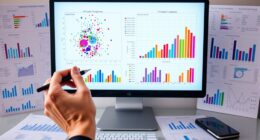When exploring time series forecasting, you often start with traditional methods like ARIMA and exponential smoothing, which work well for simple, linear patterns. For complex data with multiple seasonalities or nonlinear relationships, you can use neural networks like LSTMs, especially when combined with seasonal decomposition techniques. These approaches help capture intricate patterns and reduce noise. To discover how combining these methods can boost your forecasts, keep exploring the latest strategies.
Key Takeaways
- Traditional methods like ARIMA and exponential smoothing are effective for simple, linear patterns but struggle with complex, nonlinear data.
- Neural networks, especially RNNs and LSTMs, excel at modeling intricate temporal dependencies and nonlinear relationships.
- Seasonal decomposition techniques help isolate patterns, improve model focus, and enhance forecasting accuracy when combined with neural networks.
- Integrating decomposition methods with neural networks leads to more robust, interpretable, and precise time series forecasts.
- For limited data or resources, classical methods remain practical, while advanced approaches suit complex, multi-seasonal, and nonlinear datasets.

Time series forecasting is a powerful technique used to predict future data points based on historical observations. When you’re working with complex data, especially those exhibiting patterns like trends or seasonality, traditional methods like ARIMA or exponential smoothing might not suffice. That’s where neural networks come into play. These models can capture intricate, nonlinear relationships in your data, making them highly effective for forecasting tasks. Neural networks, particularly recurrent neural networks (RNNs) and long short-term memory (LSTM) networks, excel at recognizing temporal dependencies, allowing you to model complex time series with greater accuracy. Additionally, before applying these advanced models, seasonal decomposition can be invaluable. By breaking your data into seasonal, trend, and residual components, you simplify the underlying structure, making it easier for models to learn and forecast accurately. Seasonal decomposition helps you identify repeating patterns and irregularities, ensuring your neural networks don’t get overwhelmed by noise or confounding factors. Incorporating noise reduction techniques can further enhance model performance by minimizing the impact of random fluctuations in the data.
As you explore the modeling process, you might find that combining seasonal decomposition with neural networks enhances your forecasting accuracy. First, you decompose your time series into its constituent parts, revealing the underlying seasonal cycles and trends. Then, you can feed these components separately into your neural network or train the model on the residuals after removing seasonality. This approach helps the neural network focus on learning the most relevant signals, reducing the risk of overfitting to noise. Furthermore, understanding the seasonal patterns allows you to design better features or choose appropriate hyperparameters, further improving your model’s performance.
Neural networks are versatile and adaptable, but they require careful tuning and plenty of data to perform well. If your dataset is limited, traditional methods like exponential smoothing or ARIMA might be more practical. However, with sufficient data and computational resources, neural networks can outperform classical models, especially in capturing complex, nonlinear behaviors that simpler methods might miss. Remember, integrating seasonal decomposition into your workflow can greatly boost your model’s robustness and interpretability. It provides a clearer picture of the data’s structure, enabling your neural network to learn more effectively and generate more reliable forecasts. In essence, leveraging neural networks alongside seasonal decomposition techniques offers a powerful approach to time series forecasting, especially when dealing with complex patterns and multiple seasonalities.
Frequently Asked Questions
How to Choose the Best Forecasting Model for My Data?
To choose the best forecasting model, focus on model selection by testing different approaches like ARIMA or exponential smoothing with your data. Use feature engineering to enhance your model’s accuracy, identifying relevant patterns or external factors. Cross-validate your results, compare performance metrics, and consider your data’s complexity. This process helps you find the most reliable model, ensuring your forecasts are as accurate as possible.
What Are Common Pitfalls in Time Series Forecasting?
Think of forecasting like sailing—waves of data can toss you off course if you’re not careful. Common pitfalls include neglecting seasonality detection, which skews results, and ignoring data normalization, leaving your model vulnerable to outliers. You might also overlook stationarity or overfit your model, making predictions unreliable. Stay vigilant, verify assumptions, and preprocess your data thoroughly to navigate these hazards smoothly.
How Do I Handle Missing Data in Time Series?
When handling missing data in time series, you should use data imputation methods like interpolation techniques to fill gaps accurately. Linear interpolation works well for small gaps, while more advanced methods like spline or polynomial interpolation can handle complex patterns. Avoid simply deleting data points, as it can distort your analysis. Proper imputation guarantees your dataset remains consistent, improving the reliability of your forecasts and overall model performance.
Can Deep Learning Improve Time Series Forecasts?
Imagine your data as a chaotic dance party—neural networks step in as the ultimate DJ, remixing missing beats with precision. Yes, deep learning can improve forecasts by using neural networks for data imputation, capturing complex patterns traditional methods might miss. This approach brings a fresh rhythm to your predictions, turning incomplete or noisy data into a harmonious forecast, making your insights sharper and more reliable.
How to Evaluate the Accuracy of Different Models?
You evaluate your models’ accuracy through model validation, which involves testing how well they perform on unseen data. Use error metrics like Mean Absolute Error (MAE), Root Mean Squared Error (RMSE), or Mean Absolute Percentage Error (MAPE) to quantify prediction errors. Comparing these metrics helps you identify which model is most reliable, ensuring your forecasts are accurate and robust for decision-making.
Conclusion
Mastering techniques like ARIMA and exponential smoothing equips you to forecast with confidence. Remember, “a stitch in time saves nine”—addressing patterns early can prevent bigger issues down the line. By understanding these methods and exploring beyond, you’ll be better prepared to interpret data trends and make informed decisions. Keep learning and adapting; effective forecasting isn’t just about tools, it’s about insight and foresight that stand the test of time.










